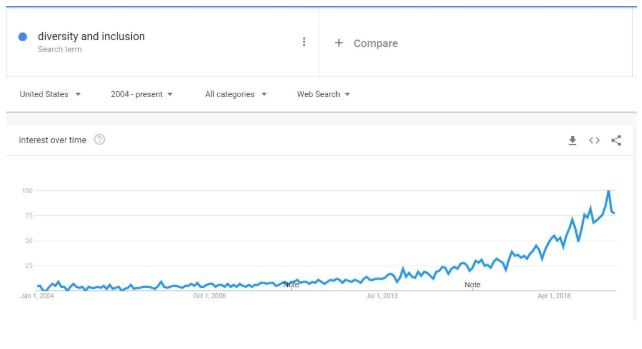For too long web accessibility was just overlooked. It was deemed too complex, too time consuming and too expensive. But even when it was addressed it was all about compliance and a standard that needed to be achieved.
Accessibility in Diversity and Inclusion Connection
But web accessibility isn’t just about meeting standards– it’s more about taking the proper stance on inclusion and diversity and how to be inclusive of those with disabilities.

Opensource states, “A diverse workforce should include people with disabilities.” A diverse customer and prospect base includes them as well.
The graph of the search trend for “diversity and inclusion” looks like a tidal wave, but few in business need to see the graph. They have seen the movement first hand in their organizations, trade groups and the overall workforce. Diversity and Inclusion is more than a trend, it’s the standard.
Diversity and Inclusion Benefits
One key benefit of D&I is that it’s not only about a company’s brand or reputation, it’s better for the bottom line too. Forbes quotes a study showing diverse companies produce 19% more revenue. It means improved business performance, outreach to new audiences and avoiding potential litigation. No business can afford to be left behind in diversity and inclusion.
But, two key points of diversity and inclusion are not so obvious:
- Inclusion also means including those with disabilities or impairments.
- It’s not just physical structures: it’s your digital properties too.
Technology empowers and enables. It enables your business to reach regionally, nationally or even globally. As your reach spreads, so does your responsibility. Many if not most new customers first discover an organization through its website. What are their thoughts? What are their impressions of your brand?
For many like Priscilla Yeung in a recent Forbes article “Accessibility allows me to be an active participant on an equal playing field and not just a bystander. It allows me to be in the moment instead of left frustrated and wondering what I am missing.” What would her impression be of your brand?
While we can’t know all the ways your customers and prospects will see the relationship, here are…
9 reasons to add accessibility in diversity and inclusion:
- When you step back to take in the bigger picture of your business, it reveals that many perceive your website is your organization.
- If you postpone any aspect of inclusion, you could be called out for not walking your talk.
- Conversely, the impact of including accessibility as part of diversity and inclusion has bang-for-the-buck since your website is likely to accommodate your biggest audience.
- Doesn’t it demonstrate more understanding to include those with disabilities in your inclusion program?
- Having a website that isn’t accessible is like a hospital with no ramps and rails. You can’t afford a dismissive attitude towards a customer segment physically…or online.
- There’s momentum and you don’t want to be left behind. The Web Accessibility Initiative notes how Apple has showcased its innovativeness by optimizing touchscreens for accessibility. A Fast Company article reveals how designing for the disabled is giving Google an edge. And who can forget Microsoft’s Superbowl ad “We All Win”?
- According to the Muse, accessibility can affect your recruiting and widen your doors for talented candidates and employees
- Asserting accessibility for those with disabilities affirms your organization’s stance to your team, helping everyone involved feel good about who they work for.
- To wait adds weight- possible discomfort in your team and the burden of wondering who might have been helped but was left out.
You might feel called to join the web accessibility movement by examples like Apple, Google and Microsoft. Or you may already know it’s the right thing to do and the right time to do it. In either case doesn’t it make sense to take steps now, to minimize your worries by casting aside the wait, and to gain the confidence and security of a brighter future of growing your audience.
Fortunately, many solutions exist. New developments in artificial intelligence and deep learning are lessening the burden of ensuring your digital properties are accessible while empowering those with disabilities to more deeply experience the world around them. There is no one magic bullet that works for everybody. The right solution is the one that aligns with your team, resources, and goals.
Including accessibility in diversity and inclusion is a must. Without accessibility an organization can’t be truly inclusive. We can help. To start a conversation, or to identify a path forward that makes sense for you, contact us at info@digitalecho.io or on LinkedIn.
